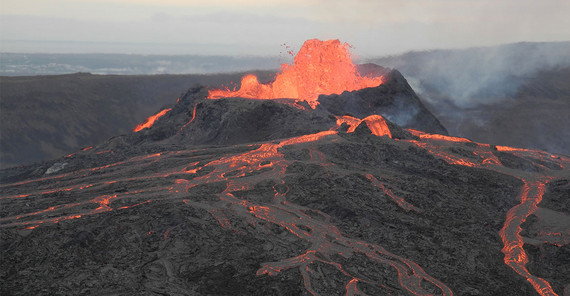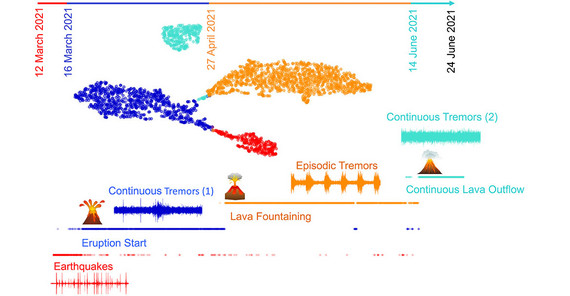The research team led by geophysicist Zahra Zali, former doctoral student in the DFG Research Training Group “NatRiskChange” at the University of Potsdam and now postdoc at GFZ, analysed the seismic signals before and during the Geldingadalir eruption on the Icelandic Reykjanes peninsula in 2021. It was the first in a series of – so far – five volcanic events there, most recently in December 2023 and January 2024 near Grindavík. The researchers used machine learning and music processing methods for their analyses and developed them further. Thus they were able to identify various previously hidden signatures in the “sound of the volcano” that were characteristic of the various eruption phases. In particular, they detected a tremor sequence three days before the eruption, which could indicate imminent eruptive activity.
To accurately decompose and analyse seismic data related to volcanic eruptions, Zahra Zali and her colleagues have further developed special machine learning methods, so-called deep embedded clustering, and musical signal processing. Application of musical signal processing in seismology were inspired and initiated by the work of Prof. Frank Scherbaum, who created a new field of research at the interface of musicology and seismology at the University of Potsdam (see SeismoSoundScape-Lab) about ten years ago. They used these techniques to analyse seismic data recorded before and during the eruption at Geldingadalir in Iceland, which began on 19 March 2021.
“Using the method of deep embedded clustering, we were able to cluster signals of similar structure in our seismic data and thus recognise previously hidden patterns. We are using a so-called unsupervised machine learning approach. The advantage over other machine learning methods is that it can be applied to unlabeled data and delivers results independently and quickly – almost in real time,” explains Zahra Zali. In order to verify these initial results and extract both volcanic tremor and transient signals, i.e. sudden earthquakes, she has further developed the method for analysing seismic signals as part of her doctoral thesis: “I was inspired by the idea of harmonic-percussive separation in musical signal processing: in order to identify different instruments in a piece of music, different types of sounds have to be separated from each other, for example the harmonic sounds of melodious violins from the percussive sounds of a drum”.
In summary, the new method offers a fast and reproducible approach to automatically decipher the temporal evolution of a volcanic system: Based on raw seismic signals, relevant features can be identified even without prior data processing to potentially gain unexpected insights.
Link to Publication: Zali, Z., Mousavi, S.M., Ohrnberger, M., Eibl, E.P.S. and Cotton, F. Tremor clustering reveals pre-eruptive signals and evolution of the 2021 Geldingadalir eruption of the Fagradalsfjall Fires, Iceland. Commun Earth Environ 5, 1 (2024). https://doi.org/10.1038/s43247-023-01166-w
Image 1: Eruption at Geldingadalir in Iceland in 2021. Image credit: Eva Eibl.
Image 2: Earthquake signals and corresponding eruption phases caused during the Icelandic Geldingadalir eruption from March to June 2021. Image credit: Zahra Zali.
Contact:
Prof. Dr. Eva Eibl
Institute of Geosciences
Phone: +49 331 977-203102
Email: eva.eibluuni-potsdampde
Dr. Zahra Zali
Helmholtz Centre Potsdam
GFZ German Research Centre for Geosciences
Phone: +49 331 6264-3098
Email: zahra.zaliugfz-potsdampde


